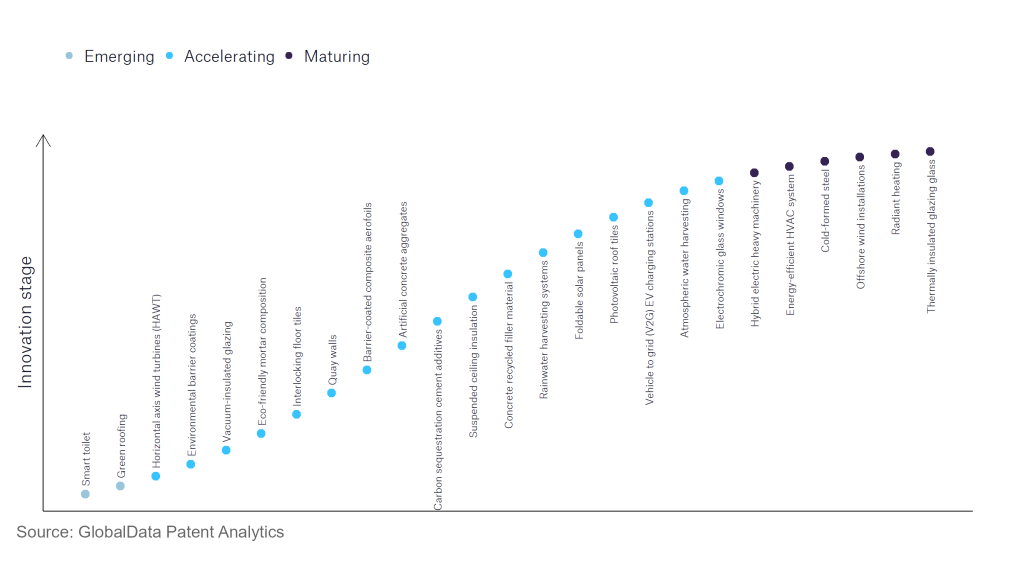The construction industry continues to be a hotbed of innovation, with activity driven by an increased focus on environmental sustainability and workplace safety, and the growing importance of technologies such as circular construction, the Internet of Things (IoT) and robotics. In the last three years alone, there have been over 248,000 patents filed and granted in the construction industry, according to GlobalData’s report on Environmental sustainability in Construction: Quay walls. Buy the report here.
However, not all innovations are equal and nor do they follow a constant upward trend. Instead, their evolution takes the form of an S-shaped curve that reflects their typical lifecycle from early emergence to accelerating adoption, before finally stabilising and reaching maturity.
Identifying where a particular innovation is on this journey, especially those that are in the emerging and accelerating stages, is essential for understanding their current level of adoption and the likely future trajectory and impact they will have.
80+ innovations will shape the construction industry
According to GlobalData’s Technology Foresights, which plots the S-curve for the construction industry using innovation intensity models built on over 179,000 patents, there are 80+ innovation areas that will shape the future of the industry.
Within the emerging innovation stage, green roofing is a disruptive technology that is in the early stages of application and should be tracked closely. HAWT wind turbines, environmental barrier coatings, and vacuum-insulated glazing are some of the accelerating innovation areas, where adoption has been steadily increasing. Among maturing innovation areas are hybrid electric heavy machinery and energy-efficient HVAC system, which are now well established in the industry.
Innovation S-curve for environmental sustainability in the construction industry

Quay walls are a key innovation area in environmental sustainability
A quay wall is an earth retaining structure, located on the sea, a lake or river, or inside a harbour, where waterborne vessels can dock. Quay walls will also commonly be equipped with the required superstructure, such as fenders, bollards and cranes, necessary to allow the transshipment of goods and containers.
GlobalData’s analysis also uncovers the companies at the forefront of each innovation area and assesses the potential reach and impact of their patenting activity across different applications and geographies. According to GlobalData, there are 10+ companies, spanning technology vendors, established construction companies, and up-and-coming start-ups engaged in the development and application of quay walls.
Key players in quay walls – a disruptive innovation in the construction industry
‘Application diversity’ measures the number of different applications identified for each relevant patent and broadly splits companies into either ‘niche’ or ‘diversified’ innovators.
‘Geographic reach’ refers to the number of different countries each relevant patent is registered in and reflects the breadth of geographic application intended, ranging from ‘global’ to ‘local’.
Patent volumes related to quay walls
| Company | Total patents (2021 - 2023) | Premium intelligence on the world's largest companies |
| China Communications Construction Group | 20 | Unlock Company Profile |
| Samsung C&T | 16 | Unlock Company Profile |
| Ackermans & Van Haaren | 15 | Unlock Company Profile |
| Hitachi Zosen | 13 | Unlock Company Profile |
| Sembcorp Marine | 12 | Unlock Company Profile |
| HALO Maritime Defense Systems | 11 | Unlock Company Profile |
| Neo Tech | 9 | Unlock Company Profile |
| Royal BAM Group | 9 | Unlock Company Profile |
| Heiwado | 8 | Unlock Company Profile |
| US Government | 8 | Unlock Company Profile |
| JFE Holdings | 6 | Unlock Company Profile |
| KYB | 6 | Unlock Company Profile |
| Hyundai Heavy Industries Holdings | 5 | Unlock Company Profile |
| Sekwang Engineering Consultants | 5 | Unlock Company Profile |
| Steel Flower | 5 | Unlock Company Profile |
Source: GlobalData Patent Analytics
Leading companies in the development of quay walls include Ackermans & Van Haaren, a construction engineering and dredging services provider. Key innovations patented by Ackermans & Van Haaren in the space include a method for constructing a water barrier, in which a core of quarry run is arranged on the underwater bottom and provided with a protective layer of stones or concrete blocks, with the proviso that the underwater bottom is raised using bottom material. It is particularly suitable for constructing a water barrier for relatively deep water. Samsung C&T, an engineering and construction provider, is also a leading developer of quay wall innovations. Key patents by Samsung C&T include a superstructure with multiple reflection blocks and shore protection to reduce construction costs and reduce reflecting waves by decreasing wave pressure.
In terms of geographic reach, leading companies in the space include Sembcorp Marine, a provider of design and engineering solutions for the marine, offshore and energy industries, and KYB, a manufacturer of hydraulic pumps.
In terms of application diversity, leading quay wall innovators include JFE, a steel manufacturer and provider of environmental services, and Hyundai Heavy Industries, a shipbuilding company and heavy equipment manufacturer.
To further understand the key themes and technologies disrupting the construction industry, access GlobalData’s latest thematic research report on Construction.
Data Insights
From

The gold standard of business intelligence.
Blending expert knowledge with cutting-edge technology, GlobalData’s unrivalled proprietary data will enable you to decode what’s happening in your market. You can make better informed decisions and gain a future-proof advantage over your competitors.



